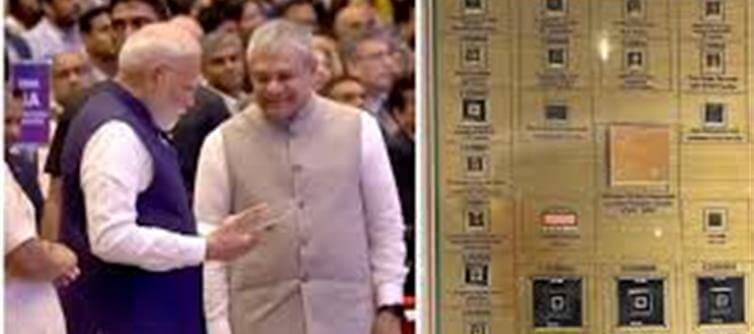
.jpg)
At Semicon india 2025 in Delhi, Union IT minister Ashwini Vaishnaw presented the Vikram 32-bit processor, India’s first indigenous microprocessor, to Prime minister Narendra Modi. This marks a significant milestone in India’s semiconductor journey.
1. What is Vikram?
Vikram is a fully indigenous 32-bit microprocessor developed by ISRO’s Semiconductor Lab.
It is qualified for use in harsh conditions, including launch vehicles, making it suitable for aerospace and defense applications.
The processor is a step toward india becoming self-reliant in semiconductor design and manufacturing.
2. Fabrication and Packaging
The fabrication and packaging of vikram chips were done at the Semiconductor Hub in Mohali, Punjab.
The first commercial rollout is expected through CG-Semi at the OSAT pilot facility in Sanand, Gujarat.
The Sanand unit was approved by the government in 2023, as part of India’s push to establish domestic semiconductor manufacturing.
3. india Semiconductor Mission (ISM) and the DLI Scheme
The India Semiconductor Mission (ISM) was launched in 2021 to boost domestic semiconductor design and manufacturing.
Through the Design Linked Incentive (DLI) scheme, 23 chip design projects have been sanctioned to support startups and innovators.
Companies like Vervesemi Microelectronics are creating advanced chips for defense, aerospace, electric vehicles, and energy systems.
4. Strategic Importance of Semiconductors
Semiconductors power almost every modern device: healthcare equipment, transportation systems, communication devices, defense applications, and space technology.
By producing chips like Vikram, india aims to reduce dependency on imports and strengthen economic and strategic independence.
The chip positions india not just as a consumer, but as a creator of advanced technology.
5. government Support and Investments
So far, 10 semiconductor manufacturing projects have been approved with cumulative investments of ₹1.60 lakh crore across Gujarat, Assam, Uttar Pradesh, Punjab, Odisha, and Andhra Pradesh.
Construction of five semiconductor units is already underway, reflecting the government’s fast-paced push to build a domestic ecosystem.
6. Global Significance
Minister Vaishnaw highlighted that despite global policy uncertainty, India offers stability and growth, making it an attractive destination for technology investments.
The successful creation of vikram has made the world look at india with confidence in the semiconductor space.
7. What This Means for India
First step toward self-reliance: india is no longer dependent on importing chips for critical applications.
Boost for startups and innovation: The DLI scheme and semiconductor units encourage homegrown technology development.
Strategic autonomy: vikram strengthens India’s position in defense, aerospace, space research, and high-tech industries.
In Summary
The Vikram 32-bit processor is more than just a chip—it symbolizes India’s technological independence and its emergence as a player in global semiconductor innovation. From ISRO’s labs in Mohali to commercial production in Gujarat, vikram showcases India’s ability to design, fabricate, and deploy advanced processors for strategic and commercial use.




 click and follow Indiaherald WhatsApp channel
click and follow Indiaherald WhatsApp channel